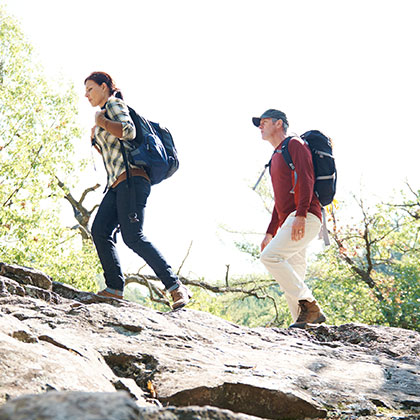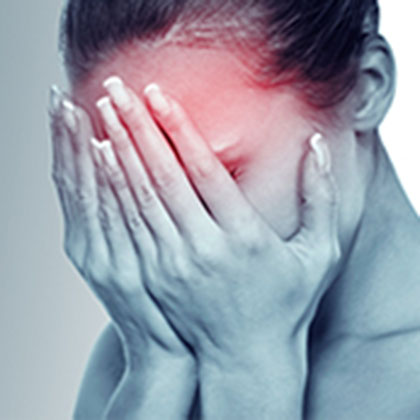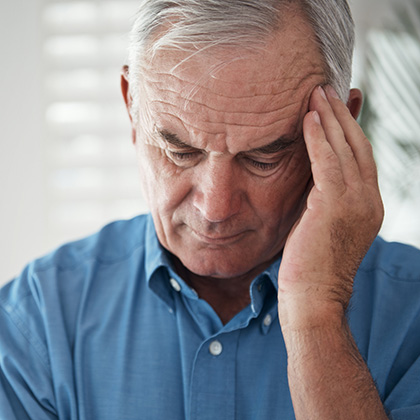If the thought of having to travel makes you think twice about going on holiday, there’s a good chance you’re one of the estimated 20 million people in the UK affected by travel or sea sickness (i). Also called motion sickness, it can cause unpleasant symptoms when you travel by air, boat, train, coach or car.
At first you may feel dizzy and nauseated (with or without vomiting), your skin may turn pale and you may feel a cold sweat. You may also feel drowsy or very tired, and you may also develop a headache. Some people find their breathing becomes rapid and shallow too.
Motion sickness is most common in children aged between two and 12 years old (ii), with adult women considered more likely to be affected by motion sickness than men, especially those who are pregnant or having a period. People who suffer from migraines are also thought to be more susceptible to motion sickness than those who don’t have migraines (iii). You can find more information about the symptoms and treatments of migraines here.
Sensory mismatch
Experts believe motion sickness is the result of a conflict between two of your senses – namely your vision and your sense of balance.
Your eyes and the vestibular system in your inner ears constantly send signals to your brain about where you are and how you’re moving. When you’re travelling, your vestibular system – a network of nerves, channels and fluids in your inner ear – detect repeated movements, such as going over bumps or around corners in the road, or the up and down motions of going over waves.
But as far as your eyes are concerned, you’re sitting still – especially if all you can see is the back of the front seat of a car or if you’re trying to read. The conflicting signals confuse your brain, and the result is dizziness, queasiness and other motion sickness symptoms.
Interestingly, experts believe you’re more likely to experience motion sickness if you’re worried about feeling travel sick or seasick. Other things that may make you more likely to suffer motion sickness include strong smells such as petrol fumes, being in a stuffy environment or having just had a big meal. Even the thought of food can make you feel worse. Some also believe there may be genetic factors at play, as Asians may be more likely to suffer from motion sickness than people from other ethnic backgrounds (iv).
And it isn’t just travel that can trigger motion sickness, as some people can also be affected on fairground rides, while watching films with lots of action or motion, and even while playing computer games.
Thankfully the symptoms of motion sickness tend to get better as your brain starts to adapt to the movement – which is good news if you’re on a cruise (though some people’s brains don’t adapt and they feel sick until they’re back on dry land).
Motion sickness: how to feel better
If your symptoms tend to be mild, there are several things you can do before and while you’re travelling to help yourself feel more human:
-
Try not to look at the landscape rushing by or waves going up and down – instead, aim to fix your vision straight ahead, just above the horizon.
-
Avoid sitting facing backwards from your direction of travel, and if possible, sit in the front seat if you’re travelling by car. Also avoid reading if you suffer from motion sickness.
-
If you’re travelling by plane, try to sit over the wing in the middle, as this is where there’s the least movement. The best place to sit or book a cabin in a boat or ship is also the middle, on a lower level.
-
If you can, open some windows to get some fresh air.
-
Avoid eating big meals before you travel or while you’re travelling (some people find eating fatty or rich foods make the symptoms of motion sickness worse). It’s also a good idea to not drink alcohol or smoke when you’re travelling, as these can make travel sickness worse too.
-
Try to avoid getting anxious about the journey, as worrying about getting travel sickness can make you more likely to be affected by it. While you’re travelling, also try to stay away from other people who may be feeling ill, as hearing them talk about being travel sick or seeing them being ill can make you start to feel ill too.
-
If you’re booking a cruise, choose a large, modern ship that has stabilisers, and avoid going to places or times of the year when the sea is likely to be rough (such as the Caribbean during hurricane season, for instance). A cruise that stops at lots of ports may also be a better option than one that stays on the open sea for days at a time.
Motion sickness treatments
There are a couple of treatments available for motion sickness available over the counter at pharmacies, without a prescription. These are suitable for more severe cases of motion sickness, and should be used before you set off on your journey, rather than after any symptoms have developed.
-
Hyoscine hydrobromide is considered an effective treatment for preventing motion sickness. It’s available in tablet form, and works by blocking some of the conflicting signals sent to your brain by your vestibular system. You have to take the tablets around 30-60 minutes before travelling, and the effects can last for up to six hours.
If you’re affected by severe travel sickness – or if you’re going on a long journey, a cruise for instance – you can use a hyoscine skin patch that may prevent you from getting travel sick for up to three days (after which you can apply another patch). However, the patches are only available on prescription from your GP and are not suitable for children younger than 10.
There are side effects with hyoscine, including a dry mouth, dizziness, drowsiness and blurred vision, which means it’s not recommended for those who are driving. If you have a medical condition – including epilepsy or heart, kidney or liver problems – speak to your GP before taking hyoscine. Also use with caution in children and older people. -
Antihistamine tablets are also thought to be useful for motion sickness, as they may help manage nausea and vomiting in addition to treating the symptoms of allergies. Again you should take them before you start to travel – usually an hour or so beforehand – and if your journey lasts more than eight hours you may need to take a second dose.
The advantage of antihistamines is that they tend to cause fewer side effects than hyoscine – though some older types of antihistamines are known to cause drowsiness (again making them unsuitable for drivers). They are, however, considered less effective than hyoscine in preventing motion sickness symptoms. -
Acupressure bands may be worth a try if you can’t take hyoscine or antihistamines (or if you favour a more natural approach). These are stretchy wristbands that include a little rubber node that applies pressure to an acupuncture point on the inside of your wrists (the point is called P6 and is located three finger widths below the wrist on the inner forearm in between the two tendons).
There’s no significant scientific evidence to suggest acupressure bands work as a treatment for motion sickness, but many people who’ve used them say they worked for them. interestingly, the stimulation of the P6 acupuncture point has been shown in studies to relieve nausea and vomiting in pregnancy (v) as well as post-operative nausea and vomiting (vi).
What is mal de débarquement syndrome?
It’s normal to feel slightly off balance after a long journey. But if you feel a rocking or swaying sensation for more than two days following a cruise, flight or other type of travel experience, you may have mal de débarquement syndrome (MdDS).
Many people get the sensation of continued movement immediately after getting off a boat, plane, train or a form of road transport. But for most of us it lasts for just a short time. According MdDS UK, people who are affected by MdDS experience the sensation for many weeks, months or even years afterwards (vii).
The main symptom is a sensation of motion such as rocking, swaying, rolling, bobbing or lurching. But some sufferers also experience other symptoms such as nausea, headache, ear pain or ear fullness, tinnitus, anxiety and depression. These symptoms can change from day to day, with some people saying they feel worse at the end of the day. Some people with MdDS say the sensation of movement improves when they’re in a moving car, train, bus, plane or boat.
Research into what causes MdDS was previously thin on the ground, but scientists are now beginning to look at it more seriously. Two theories have recently emerged as to what may cause it (viii):
-
MdDs is a disorder of abnormal functional connectivity in the brain during motion exposure.
-
The other theory involves a problem with the vestibulo-ocular reflex (VOR), which stabilises your vision when you rotate your head.
It’s also thought that middle-aged women are far more likely to be affected by MdDS than men or younger women – though experts don’t know why (ix).
How is it treated?
Currently there is no cure for MdDS, and treatments that are used to treat motion sickness and other types of dizziness are thought to have little effect on MdDS. Some medicines, such as benzodiazepines and antidepressants called selective serotonin reuptake inhibitors (SSRIs), are used to manage some – but not all – of the syndrome’s symptoms.
Vestibular rehabilitation therapy – which is often used to treat balance problems such as labyrinthitis – and physical exercise are also thought to be useful for some MdDS sufferers.
For more information, visit www.mddsfoundation.org.
Natural remedies for motion sickness
If you don’t want to take travel sickness tablets – you may not want to feel drowsy, for instance – there are a few natural remedies you could try that may help:
Ginger
Taken either as food or drink, or as a nutritional supplement, ginger is widely thought to help prevent symptoms of motion sickness (x) and is a popular traditional remedy for nausea and vomiting. In fact, it’s thought to have been used as early as the fourth century BC in China as a treatment for nausea and other complaints. In Germany, it has been officially approved as a treatment for indigestion and motion sickness. One study even claims ginger is as effective at treating sea sickness as an antiemetic travel sickness drug called dimenhydrinate (xi).
L-Theanine
Anxiety about motion sickness is generally thought to make the condition worse. So if you worry about getting travel sick before you’ve even finished packing your suitcase, it may be a good idea to try a natural supplement that reduces your stress levels, such as the amino acid L-Theanine. There is some evidence that L-Theanine may help reduce stress without causing drowsiness (xii).
Peppermint oil
If travelling leaves you with a churning stomach, peppermint oil capsules may help. Peppermint is widely thought to help soothe the stomach, thanks to the antispasmodic effects of its main ingredients, menthol and methyl salicylate.
Motion sickness can be difficult when travelling, but taking some of the steps above should help alleviate the symptoms.
To find out about other medical considerations to take when travelling, read our article about common . Alternatively, discover the articles in our health library to learn more about common health conditions.
References:
-
Available online: https://www.telegraph.co.uk/motoring/caraccessories/8688774/Coping-with-travel-sickness.html
-
Available online: https://www.betterhealth.vic.gov.au/health/healthyliving/motion-sickness
-
Cuomo-Granston A., Drummond PD Migraine and motion sickness: what is the link? Prog Neurobiol. 2010 Aug;91(4):300-12.Available online: https://www.ncbi.nlm.nih.gov/pubmed/20416353
-
Available online: https://news.psu.edu/story/141284/2005/03/30/research/probing-question-motion-sickness-your-genes
-
Werntoft. E, Dykes. AK. Effect of acupressure on nausea and vomiting during pregnancy. A randomized, placebo-controlled, pilot study. J Reprod Med. 2001 Sep;46(9):835-9.
-
Nunley. C, Wakim. J, Guinn. C J. The effects of stimulation of acupressure point p6 on postoperative nausea and vomiting: a review of literature Perianesth Nurs. 2008 Aug;23(4):247-61.
-
Available online: https://www.mdds.org.uk
-
Mucci V et al., Perspective: Stepping Stones to Unravelling the Pathophysiology of Mal de Debarquement Syndrome with Neuroimaging. Front Neurol. 2018 Feb 12.Available online: https://www.frontiersin.org/articles/10.3389/fneur.2018.00042/full
-
Available online: https://www.menieres.org.uk/information-and-support/symptoms-and-conditions/mal-de-debarquement
-
Grontved. A, Brask. T, Kambskard. J, et al. Ginger root against seasickness. A controlled trial on the open sea. Acta Otolaryngol. 1988;105:45-49.
-
Mowrey. DB, Clayson. DE, Kambskard. J. Motion sickness, ginger, and psychophysics. Lancet. 1982;1:655-657.
-
Riebenfeld. D, Borzone. L. Randomized double-blind study comparing ginger (Zintona?) and dimenhydrinate in motion sickness. Healthnotes Rev. 1999;6:98-101.
-
White DJ et al., Anti-Stress, Behavioural and Magnetoencephalography Effects of an L-Theanine-Based Nutrient Drink: A Randomised, Double-Blind, Placebo-Controlled Crossover Trial. Nutrients. 2016 Jan;8(1):53.Available online: https://www.ncbi.nlm.nih.gov/pmc/articles/PMC4728665/
-
Juneja. LR. Suntheanine and its relaxation effect in humans. Trends in Food Science & Tech. 1999;10;199-204.
-
Kimura. K, Ozeki. M, Juneja. H. L-Theanine reduces psychological and physiological stress responses. Biol Psychol. 2007;74(1):39-45.
Related Posts
Disclaimer: The information presented by Nature's Best is for informational purposes only. It is based on scientific studies (human, animal, or in vitro), clinical experience, or traditional usage as cited in each article. The results reported may not necessarily occur in all individuals. Self-treatment is not recommended for life-threatening conditions that require medical treatment under a doctor's care. For many of the conditions discussed, treatment with prescription or over the counter medication is also available. Consult your doctor, practitioner, and/or pharmacist for any health problem and before using any supplements or before making any changes in prescribed medications.

Christine
Christine Morgan has been a freelance health and wellbeing journalist for almost 20 years, having written for numerous publications including the Daily Mirror, S Magazine, Top Sante, Healthy, Woman & Home, Zest, Allergy, Healthy Times and Pregnancy & Birth; she has also edited several titles such as Women’ Health, Shine’s Real Health & Beauty and All About Health.
View More



